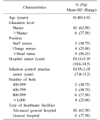Abstract
Background
The aim of this study was to examine in detail the difficulties infection control nurses (ICN) experience in their work, and to investigate their roles during Middle East Respiratory Syndrome (MERS) outbreaks, using qualitative methods.
Methods
Two focus groups were formed by convenience sampling of eight infection control nurses from each of the hospitals where patients with suspected or confirmed MERS were hospitalized and from those hospitals where no MERS cases were found. One interview each was conducted for both of focus groups in November 2015. Contents of the focus group discussions were analyzed for the investigated features and categories.
Results
When MERS outbreaks occurred, ICNs provided suggestions on applications of policies, rules and procedures, reporting and communication; participated in education and trainings, consultations, detection and monitoring of MERS cases; and controlled infection among staff. Depending on the type of work, they had various roles such as coordinator, decision maker, administrator, information provider, educator, leader, consultant, and epidemiological investigator.
Conclusion
Infection control nurses performed various tasks and played an important role during a MERS outbreak. They experienced difficulties at a personal level as well as in their work environment. Therefore, it is necessary to provide a systematic education program to enhance ICNs competency, while clearly defining their role to help them cope with the infection crisis effectively. In addition to the national level, a system for self-supporting medical institutions should be established.
References
1. Korea Centers for Disease Control and Prevention (KCDC). 2016 Middle east respiratory syndrome (MERS) manual. Osong: Ministry of health and welfare, Korea Centers for Disease Control and Prevention;2016. Updated on 1 February, 2016. http://www.cdc.go.kr/CDC/info/CdcKrHealth0289.jsp?menuIds=HOME001-MNU2374-MNU2375-MNU1509-MNU1913&fid=5742&q_type=&q_value=&cid=66987&pageNum=1.
2. Korea Centers for Disease Control and Prevention (KCDC). Middle East Respiratory Syndrome Coronavirus Outbreak in the Republic of Korea, 2015. Osong Public Health Res Perspect. 2015; 6:269–278.
3. Korean Association of Infection Control Nurse (KAICN). KAICN text of infection control. 2nd ed. Seoul: Hyunmoonbook;2012.
4. Kim OS. Role analysis of infection control nurses. In : 2007 Winter conference; Seoul: Korean Association of Infection Control Nurses;2007.
5. Choi JS, Kim KM. Crisis prevention and management by infection control nurses during the Middle East respiratory coronavirus outbreak in Korea. Am J Infect Control. 2016; 44:480–481.

6. Rebmann T, English JF, Carrico R. Disaster preparedness lessons learned and future directions for education: results from focus groups conducted at the 2006 APIC Conference. Am J Infect Control. 2007; 35:374–381.

7. Kim SJ, Kim Hj, Lee KJ, Lee SO. Focus group research methodology. Seoul: Hyunmoonsa;2000.
8. Kim KD, Lee OJ. Social research methods: theory and techniques of social research methods. Seoul: Pakyoungsa;1986.
9. Goldrick BA. The practice of infection control and applied epidemiology: a historical perspective. Am J Infect Control. 2005; 33:493–500.

10. Hospital Nurses Association. The status of infection control nurses and activities among healthcare facilities. Seoul: Hospital Nurses Association;2016.
11. Rebmann T. 2008 APIC Emergency Preparedness Committee. APIC State-of-the-Art Report: the role of the infection preventionist in emergency management. Am J Infect Control. 2009; 37:271–281.

12. Korean Nurses Association. Progress report on the institutionalization of advanced practice nurses. Seoul: Korean Nurses Association;2011.
13. Hwang IJ. Clinical decision making patterns of pediatric nurses. Korean Parent Child Health J. 2004; 15:20–32.
14. Choi KS. An Empirical study on the relationships among nurse's competence, organizational justice knowledge sharing and work performance (Master's thesis). Ulsan: University of Ulsan;2014. 1–80. Retrieved from http://www.riss.kr/link?id=T13540296.
15. Choi JS, Kim KM. Factors influencing the self-perceived practice levels of professional standard competency among infection control nurses in Korea. Am J Infect Control. 2014; 42:980–984.

16. Medical Law Enforcement Rules [Operation 2016.10.6.]. [Ordinance of the Ministry of Health and Welfare No. 442, 2016.10.6. Partial revision]. Updated on 6 October, 2016. http://www.law.go.kr/lsSc.do?menuId=0&p1=&subMenu=1&nwYn=§ion=&tabNo=&query=#undefined.
17. SIQI X. Comparative analysis of the chinese and Korean media news reporting in the MERS crisis: focused on frame analysis (Master's thesis). Seoul: Sogang University;2016. 1–92. Retrieved from http//www.riss.kr/link\?id=T14162378, http://www.riss.kr/link?id=T14162378.
18. Seoul Metropolitan Government. Crisis management communication guidelines. Seoul: Seoul Metropolitan Government;2014. Retrieved from http//www.prism.go.kr/homepage/researchCommon/downloadResearchAttachFile.do, http://www.prism.go.kr/homepage/researchCommon/downloadResearchAttachFile.do;jsessionid=D7EA6E914EFA212285B23EFC89F812FB.node02?work_key=001&file_type=CPR&seq_no=001&pdf_conv_yn=N&research_id=6110000-201500017.




 PDF
PDF ePub
ePub Citation
Citation Print
Print



 XML Download
XML Download